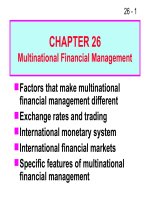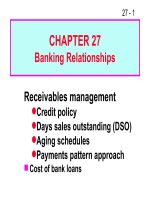FM11 Ch 21 Hybrid Financing_Preferred Stock,Warrants, and Convertibles
Bạn đang xem bản rút gọn của tài liệu. Xem và tải ngay bản đầy đủ của tài liệu tại đây (100.35 KB, 47 trang )
21 - 1
Types of hybrid securities
Preferred stock
Warrants
Convertibles
Features and risk
Cost of capital to issuers
CHAPTER 21
Hybrid Financing: Preferred Stock,
Warrants, and Convertibles
21 - 2
Preferred dividends are specified by
contract, but they may be omitted
without placing the firm in default.
Most preferred stocks prohibit the
firm from paying common dividends
when the preferred is in arrears.
Usually cumulative up to a limit.
How does preferred stock differ from
common stock and debt?
(More )
21 - 3
Some preferred stock is perpetual, but
most new issues have sinking fund or
call provisions which limit maturities.
Preferred stock has no voting rights,
but may require companies to place
preferred stockholders on the board
(sometimes a majority) if the dividend is
passed.
Is preferred stock closer to debt or
common stock? What is its risk to
investors? To issuers?
21 - 4
Advantages
Dividend obligation not contractual
Avoids dilution of common stock
Avoids large repayment of principal
Disadvantages
Preferred dividends not tax deductible,
so typically costs more than debt
Increases financial leverage, and hence
the firm’s cost of common equity
What are the advantages and disadvan-
tages of preferred stock financing?
21 - 5
Dividends are indexed to the rate on
treasury securities instead of being
fixed.
Excellent S-T corporate investment:
Only 30% of dividends are taxable to
corporations.
The floating rate generally keeps issue
trading near par.
What is floating rate preferred?
21 - 6
However, if the issuer is risky, the
floating rate preferred stock may
have too much price instability for
the liquid asset portfolios of many
corporate investors.
21 - 7
A warrant is a long-term call option.
A convertible consists of a fixed
rate bond (or preferred stock)plus a
long-term call option.
How can a knowledge of call options
help one understand warrants and
convertibles?
21 - 8
P
0
= $20.
r
d
of 20-year annual payment bond
without warrants = 12%.
50 warrants with an exercise price of
$25 each are attached to bond.
Each warrant’s value is estimated to
be $3.
Given the following facts, what
coupon rate must be set on a bond
with warrants if the total package is to
sell for $1,000?
21 - 9
Step 1: Calculate V
Bond
V
Package
= V
Bond
+ V
Warrants
= $1,000.
V
Warrants
= 50($3) = $150.
V
Bond
+ $150 = $1,000
V
Bond
= $850.
21 - 10
Step 2: Find Coupon Payment and Rate
N I/YR PV
PMT
FV
20 12 -850 1000
Solve for payment = 100
Therefore, the required coupon rate
is $100/$1,000 = 10%.
21 - 11
At issue, the package was actually
worth
V
Package
= $850 + 50($5) = $1,100,
which is $100 more than the selling
price.
If after issue the warrants immediately
sell for $5 each, what would this imply
about the value of the package?
(More )
21 - 12
The firm could have set lower
interest payments whose PV would
be smaller by $100 per bond, or it
could have offered fewer warrants
and/or set a higher exercise price.
Under the original assumptions,
current stockholders would be
losing value to the bond/warrant
purchasers.
21 - 13
Generally, a warrant will sell in the
open market at a premium above its
value if exercised (it can’t sell for
less).
Therefore, warrants tend not to be
exercised until just before expiration.
Assume that the warrants expire 10
years after issue. When would you
expect them to be exercised?
(More )
21 - 14
In a stepped-up exercise price, the
exercise price increases in steps over
the warrant’s life. Because the value of
the warrant falls when the exercise price
is increased, step-up provisions
encourage in-the-money warrant holders
to exercise just prior to the step-up.
Since no dividends are earned on the
warrant , holders will tend to exercise
voluntarily if a stock’s payout ratio rises
enough.
21 - 15
When exercised, each warrant will
bring in the exercise price, $25.
This is equity capital and holders will
receive one share of common stock
per warrant.
The exercise price is typically set some
20% to 30% above the current stock
price when the warrants are issued.
Will the warrants bring in additional
capital when exercised?
21 - 16
No. As we shall see, the warrants
have a cost which must be added to
the coupon interest cost.
Because warrants lower the cost of
the accompanying debt issue, should
all debt be issued with warrants?
21 - 17
The company will exchange stock worth
$36.75 for one warrant plus $25. The
opportunity cost to the company is
$36.75 - $25.00 = $11.75 per warrant.
Bond has 50 warrants, so the
opportunity cost per bond = 50($11.75) =
$587.50.
What is the expected return to the bond-
with-warrant holders (and cost to the
issuer) if the warrants are expected to be
exercised in 5 years when P = $36.75?
(More )
21 - 18
Here are the cash flows on a time line:
0 1 4 5 6 19 20
+1,000 -100 -100 -100 -100 -100 -100
-587.50 -1,000
-687.50 -1,100
Input the cash flows into a calculator to
find IRR = 14.7%. This is the pre-tax
cost of the bond and warrant package.
(More )
21 - 19
The cost of the bond with warrants
package is higher than the 12%
cost of straight debt because part
of the expected return is from
capital gains, which are riskier than
interest income.
The cost is lower than the cost of
equity because part of the return is
fixed by contract.
(More )
21 - 20
When the warrants are exercised,
there is a wealth transfer from
existing stockholders to
exercising warrant holders.
But, bondholders previously
transferred wealth to existing
stockholders, in the form of a low
coupon rate, when the bond was
issued.
21 - 21
At the time of exercise, either more
or less wealth than expected may be
transferred from the existing
shareholders to the warrant holders,
depending upon the stock price.
At the time of issue, on a risk-
adjusted basis, the expected cost of
a bond-with-warrants issue is the
same as the cost of a straight-debt
issue.
21 - 22
20-year, 10.5% annual coupon, callable
convertible bond will sell at its $1,000 par
value; straight debt issue would require a
12% coupon.
Call protection = 5 years and call price =
$1,100. Call the bonds when conversion
value > $1,200, but the call must occur on
the issue date anniversary.
P
0
= $20; D
0
= $1.48; g = 8%.
Conversion ratio = CR = 40 shares.
Assume the following convertible
bond data:
21 - 23
What conversion price (P
c
) is built into
the bond?
Like with warrants, the conversion
price is typically set 20%-30% above
the stock price on the issue date.
$1,000
40
P
c
=
= = $25.
Par value
# Shares received
21 - 24
Examples of real convertible bonds
issued by Internet companies
Issuer
Amazon.com
Beyond.com
CNET
DoubleClick
Mindspring
NetBank
PSINet
SportsLine.com
Size of issue
$1,250 mil
55 mil
173 mil
250 mil
180 mil
100 mil
400 mil
150 mil
Cvt Price
$156.05
18.34
74.81
165
62.5
35.67
62.36
65.12
Price at issue
$122
16
84
134
60
32
55
52
21 - 25
What is (1) the convertible’s straight
debt value and (2) the implied value of
the convertibility feature?
PV FV
20 12 105 1000
Solution: -887.96
I/YR
PMT
N
Straight debt value:









